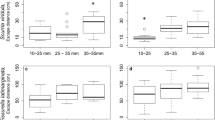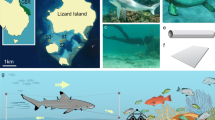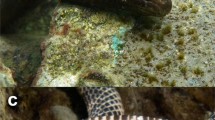Abstract
Between November 1982 and August 1984 diving observations of two intertidal limpets' defensive behaviours in response to two predatory species were made near the Seto Marine Biological Laboratory of Kyoto University, in Wakayama Prefecture, Japan, for over 800 h. The focus of the observations was a simple isolated rock, 0.9 m2 in area with an inclination of 75°. The pulmonate homing limpet Siphonaria sirius responded by fleeing from its home in response to the whelk Thais clavigera and by calmping tightly to its home scar in response to the starfish Coscinasterias acutispina. Both behaviours were successful for avoiding predation. After a whelk moved far away, limpets returned to their homes. The patellid limpet Cellana toreuma showed mantle folding behaviour or fled for an average distance of 8 cm vertically upwards in response to the whelk and for an average distance of 21 cm vertically upwards in response to the starfish. The amount of time predators spent foraging increased in the low intertidal zone relative to the mid and high zones, and most predator attacks were observed during the limpets' resting periods (submersion in late afternoon or nighttime). The upward directional flight displayed by C. toreuma was related to the upward orientation of the limpets' heads when they are in a resting position. Half of the limpets observed fleeing downward away from a starfish, a movement elicited by a downward attack, received a second attack. These limpets were preyed upon at the second encounter 67% of the time. The upward fleeing behaviour of C. toreuma resulted in the shifting of its resting site higher up the study site where fewer attacks occurred and where the mortality rate was at its lowest. It is suggested that the homing behaviour of S. sirius and the upward fleeing behaviour of C. toreuma are mechanisms by means of which interspecific competition between limpets is reduced and coexistence on a small rock surface is maintained.
Similar content being viewed by others
Literature cited
Abe, N. (1983). Escape responses of patellid limpets to carnivorous gastropods. Nanki seibutu 25: 193–194 (in Japanese)
Abe, N. (1989). Interactions between carnivorous gastropods and their sessile animal prey at a rocky intertidal shore. Physiol. Ecol. Jap. 26: 1–38
Bosman, A. L., Hockey, P. A. R., Underhill, L. G. (1989). Oystercatcher predation and limpet mortality: the importance of refuges in enhancing the reproductive output of prey populations. Veliger 32: 120–129
Branch, G. M. (1978). The responses of South African patellid limpets to invertebrate predators. Zoologica african. 13: 221–232
Branch, G. M. (1979). Aggression by limpets against invertebrate predators. Anim. Behav. 27: 408–410
Branch, G. M. (1981). The biology of limpets: physical factors, energy flow, and ecological interactions. Oceanogr. mar. Biol. A. Rev. 19: 235–380
Branch, G. M. (1985). The impact of predation by kelp gulls Larus dominicanus on the subantarctic limpet Nacella delesserti. Polar Biol. 4: 171–177
Branch, G. M., Branch, M. L. (1980). Congestion between Cellana tramoserica (Soweby) (Gastropoda) and Patiriella exigua (Lamarck) (Asteroidea) and their influence on algal standing stocks. J. exp. mar. Biol. Ecol. 48: 35–49
Branch, G. M., Barkai, A. (1988). Interspecific behaviour and its reciprocal interaction with evolution, population dynamics and community structure. In: Chelazzi, G., Vannini, M. (ed.) Behavioral adaptation to intertidal life. Plenum press, New York, p. 225–254
Bros, W. E. (1986). Mortality of the limpets, Collisella pelta (Rathke) and Notoacmaea scutum (Rathke), as a function of predation from the sea star, Pisaster ochraceus (Brandt). Bull. mar. Sci. 39: 92–101
Bullock, T. H. (1953). Predator recognition and escape responses of some intertidal gastropods in presence of starfish. Behaviour 5:130–140
Byers, B. A. (1989). Habitat-choice polymorphism associated with cryptic shell-color polymorphism in the limpet Lottia digitalis. Veliger 32: 394–402.
Dayton, P. K., Rosenthal, R. J., Mahen, L. C., Antezana, T. (1977). Population structure and foraging biology of the predaceous Chilean asteroid Meyenaster gelatinosus and the escape biology of its prey. Mar. Biol. 39: 361–370
Edwards, D. C. (1969). Predators on Olivella biplicata, including a species specific predator avoidance response. Veliger 11: 326–333
Feder, H. M. (1963). Gastropod defensive responses and their effectiveness in reducing predation by starfishes. Ecology 44: 505–512
Feder, H. M. (1967). Organisms responsive to predatory sea stars. Sarsia 29: 371–394
Feder, H. M. (1972). Escape responses in marine invertebrates. Scient. Amer. 227: 92–100
Feder, H. M., Christensen, A. M. (1966). Aspects of asteroid biology. In: Boolootian, R. A. (ed.) Physiology of echinodermata. Wiley, New York, p. 88–127
Fishlyn, D. A., Phillips, D. W. (1980). Chemical camouflaging and behavioral defenses against predatory sea star by three species of gastropods from the surfgrass Phyllospadix community. Biol. Bull. mar. biol. Lab., Woods Hole 158: 34–48
Garrity, S. D., Levings, S. C. (1981). A predator-prey interaction between two physically and biologically constrained tropical rocky shore gastropods: direct, indirect and community effects. Ecol. Monogr. 51: 267–286
Garrity, S. D., Levings, S. C. (1983). Homing to scars as a defense against predators in the pulmonate limpet Siphonaria gigas (Gastropoda). Mar. Biol. 72: 319–324
Hamilton, P. V. (1976). Predation on Littorina irrorata (Mollusca: Gastropoda) by Callinectes sapidus (Crustacea: Portunidae). Bull. mar. Sci. 26: 403–409
Harrold, C. (1982). Escape response and prey availability in a kelp forest predator-prey system. Am. Nat. 119: 132–135
Hirano, Y. (1979). Studies on activity pattern of the patellid limpet Cellana toreuma (Reeve). J. exp. mar. Biol. Ecol. 40: 137–148
Hirano, Y. (1981). Comparative ecological studies on the habitas and habits of intertidal limpets. J. Sci. Hiroshima Univ. (Ser. B) 29: 1–45
Hockey, P. A. R., Bosman, A. L., Ryan, P. G. (1987). The maintenance of polymorphism and cryptic mimesis in the limpet Scurria variabilis by two species of Cinclodes (Aves: Furnariinae) in Central Chile. Veliger 30: 5–10
Hoffman, D. L., Weldon, P. J. (1978). Flight responses of two intertidal gastropods (Prosobranchia: Trochidae) to sympatric predatory gastropods from Barbados. Veliger 20: 361–366
Hoffman, D. L., Homan, W. C., Swanson, J., Weldon, P. J. (1979). Flight responses of three congeneric species of intertidal gastropods (Prosobranchia: Neritidae) to sympatric predatory gastropods from Barbados. Veliger 21: 293–296
Iwasaki, K. (1992a). The role of individual variability in limpets' resting site fidelity and competitive ability in the organization of a rocky intertidal community. Physiol. Ecol. Jap. (submitted)
Iwasaki, K. (1992b). Factors affecting individual variation in resting site fidelity in the patellid limpet, Cellana toreuma (Reeve). Ecol. Res. 7: 305–331
Iwasaki, K. (1992c). Synergistic effects of mixed grazing by limpets on intertidal organisms. Physiol. Ecol. Jap. 29 (in press)
Kikuchi, T., Doi, T. (1987). Defensive escape response of two trochid sand snail species of the genus Umbonium: the effect of species specific escape response to asteroid predators. Publs. Amakusa mar. biol. Lab. 9: 47–65
Kohn, A. J., Waters, V. (1966). Escape responses of three herbivorous gastropods to the predatory gastropod Conus textile. Anim. Behav. 14: 340–345
Kunz, C., Connor, V. M. (1986). Roles of the home scar of Collisella scabra (Gould). Veliger 29: 25–30
Markowitz, D. V. (1980). Predator influence on shore-level size gradients in Tegula funebralis (A. Adams). J. exp. mar. Biol. Ecol. 45: 1–13
Margolin, A. S. (1964a). A running response of Acmaea to sea stars. Ecology 45: 191–193
Margolin, A. S. (1964b). The mantle response of Diodora aspera. Anim. Behav. 12: 187–194
Margolin, A. S. (1975). Responses to sea stars by three naticid gastropods. Ophelia 14: 85–92
McClintok, J. B. (1985). Avoidance and escape responses of the Sub-Antarctic limpet Nacella edgari (Powell) (Mollusca: Gastropoda) to the sea star Anasterias perrieri (Smith) (Echinodermata: Asteroidea). Polar Biol. 4: 95–98
McKillup, S. C. (1982). The selective advantage of avoidance of the predatory whelk Lepsiella vinosa (Lamarck) by Littorina unifasciata. J. exp. mar. Biol. Ecol. 63: 59–66
Menge, B. A. (1972). Foraging strategy of a starfish in relation to actual prey availability and environmental predictability. Ecol. Monogr. 42: 25–50
Menge, B. A. (1978a). Predation intensity in a rocky intertidal community: relation between predator foraging activity and environmental harshness. Oecologia 34: 1–16
Menge, B. A. (1978b). Predation intensity in a rocky intertidal community: effect of an algal canopy, wave action and desiccation on predator feeding rates. Oecologia 34: 17–35
Mercurio, K. S., Palmer, A. R., Lowell, R. B. (1985). Predator-mediated microhabitat partitioning by two species of visually cryptic, intertidal limpets. Ecology 66: 1417–1425
Miller, M. L. (1986). Avoidance and escape responses of the gastropod Nucella emarginata (Deshayes, 1839) to the predatory sea star Pisaster ochraceus (Brandt, 1835). Veliger 28: 394–396
Montogomery, D. H. (1967). Responses of two Haliotid Gastropods (Mollusca), Haliotis assimils and Haliotis rufescence, to the Forcipulate Asteroids (Echinodermata), Pycnopodia helianthoides and Pisaster ochraceus. Veliger 9: 359–368
Ohgushi, R. (1956). Observations on the behaviour of non-homing limpets. Jap. J. Malac. 19: 60–64 (in Japanese)
Ohgushi, R., Miura, T., Kotani, M. (1953). Some observations on the homing behaviors of two species of limpets. Jap. J. Malac. 17: 219–223 (in Japanese)
Paine, R. T. (1966). Food web complexity and species diversity. Am. Nat. 100: 65–75
Paine, R. T. (1969). The Pisaster-Tegula interaction: prey patches, predator food preference and intertidal community structure. Ecology 50: 950–961
Paine, R. T. (1974). Intertidal community structure: experimental studies on the relationship between a dominant competitor and its principal predator. Oecologia 15: 93–120
Paine, R. T. (1980). Food webs: linkage, interaction strength and community infrastructure. J. Anim. Ecol. 49: 667–685
Phillips, D. W. (1975a) Distance chemoreception-triggered avoidance behavior of the limpets Acmaea (Collisella) limatula and Acmaea (Notoacmaea) scutum to the predatory starfish Pisaster ochraceus. J. exp. Zool. 191: 199–210
Phillips, D. W. (1975b). Localization and electrical activity of the distance chemoreceptors that mediate predator avoidance behaviour in Acmaea limatula and Acmaea scutum (Gastropoda, Prosobranchia). J. exp. Biol. 63: 403–412
Phillips, D. W. (1976). The effect of a species-specific avoidance response to predatory starfish on the intertidal distribution of two gastropods. Oecologia 23: 83–94
Phillips, D. W., Chiarappa, M. L. (1980). Defensive responses of gastropods to the predatory flatworms Freemania litoricola (Heath and McGregor) and Notoplana acticola (Boone). J. exp. mar. Biol. Ecol. 47: 179–189
Pratt, D. M. (1974). Behavioral defenses of Crepidula formicata against attack by Urosalpinx cinerea. Mar. Biol 27: 47–49
Rice, S. H. (1985). An anti-predator chemical defense of the marine pulmonate gastropod Trimusculus reticulatus (Sowerby). J. exp. mar. Biol. Ecol. 93: 83–89
Schmitt, R. J. (1981). Contrasting anti-predator defenses of sympatric marine gastropods (family Trochidae). J. exp. mar. Biol. Ecol. 54: 251–263
Schmitt, R. J. (1982). Consequences of dissimilar defenses against predation in a subtidal marine community. Ecology 63: 1588–1601
Stimson, J. (1970). Territorial behavior of the owl limpet, Lottia gigantea. Ecology 51: 113–118
Thompson, T. E. (1960a). Defensive acid-secretion in marine gastropods. J. mar. Biol. Ass. U.K. 39: 115–122
Thompson, T. E. (1960b). Defensive adaptations in opisthobranchs. J. mar. biol. Ass. U.K. 39: 123–134
Thompson, T. E., Slinn, D. J. (1959). On the biology of the opisthobranch Pleurobranchus membranaceus. J. mar. Biol. Ass. U.K. 38: 507–524
Vermeij, G. J. (1978). Biogeography and adaptation: patterns of marine life. Harvard University Press, Cambridge, Massachusetts
Vermeij, G. J. (1982). Unsuccessful predation and evolution. Am. Nat. 120: 701–720
Warren, J. H. (1985). Climbing as an avoidance behavior in the salt marsh periwinkle, Littorina irrorata (Say). J. exp. mar. Biol. Ecol. 89: 11–28
Watanabe, J. M. (1983). Anti-predator defenses of three kelp forest gastropods: contrasting adaptations of closely-related prey species. J. exp. mar. Biol. Ecol. 71: 257–270
Wells, R. A. (1980). Activity pattern as a mechanism of predator avoidance in two species of acmaeid limpet. J. exp. mar. Biol. Ecol. 48: 151–168
Wolcott, T. G. (1973). Physiological ecology and intertidal zonation in limpets (Acmaea): a critical look at “limiting factors”. Biol. Bull. mar. biol. Lab., Woods Hole 145: 389–422
Author information
Authors and Affiliations
Additional information
Communicated by T. Ikeda, Niigata
Rights and permissions
About this article
Cite this article
Iwasaki, K. Analyses of limpet defense and predator offense in the field. Marine Biology 116, 277–289 (1993). https://doi.org/10.1007/BF00350018
Received:
Accepted:
Issue Date:
DOI: https://doi.org/10.1007/BF00350018




